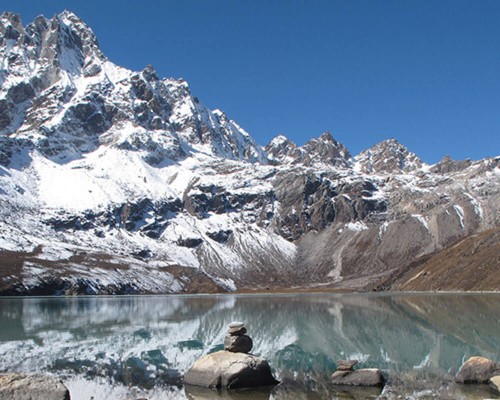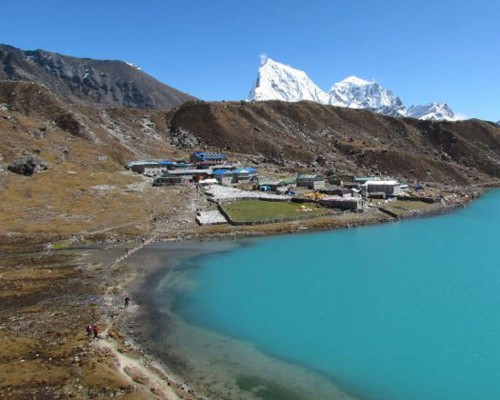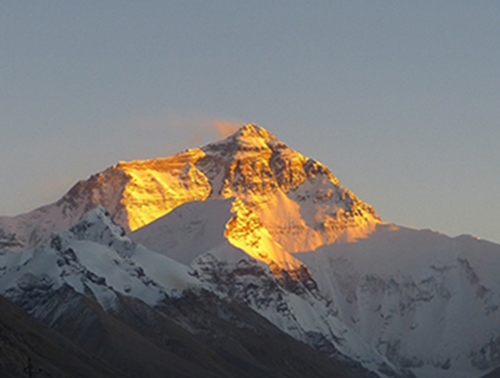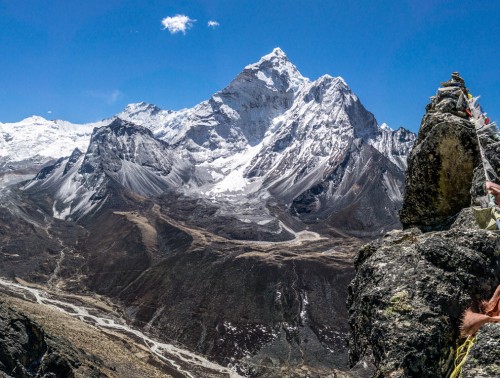Trip Grade: Fitness Level and Health at Gokyo and Renjo La Pass Trek
Trek to Gokyo and Renjo La Pass is one of the toughest treks in the Everest region. Still, it is possible to accomplish through determination and training. This trek demands you to walk for 5 to 8 hrs per day. However, it varies depending on the physical fitness of a person. Hiking into the wilderness at high altitude for hours on steep and rugged terrain makes it more adventurous and challenging for the trekkers. Furthermore, crossing one of the three high pass of Everest region, Renjo La Pass (5,360m) is not an easy task. Despite the quite high elevation of Renjo La Pass, it is not that steepest enough to be the most difficult to climb on it. Beside that it is the lowest pass among the three passes and trekkers do not have to cross the glacier. Gokyo Ri viewpoint (5,357m) is the another steep uphill climb to savour the beautiful mountains of Khumbu regions.
As this trek is demanding in nature , it would be beneficial for you to do jogging, short hike, or any cardio related workout before the trek inorder to boost stamina and strength. This trek don’t need any experience and skills therefore, a fit and healthy body with strong determination is enough for you to trek. If you have any past experience of trekking or hiking it is a bonus.
Please do inform us before booking a trip if any of the participants has pre-existing medical conditions associated with heart, lung and blood diseases.
Accommodation
While trekking we will be lodging at local tea houses/guesthouse where they provide a clean and comfy place to sleep as well as warm home cooked meals. Most of the lodges have twin sharing rooms and dormitory room so usually, two or more trekkers have to share the one room with an attached or common bathroom and usually has a western style toilet. They generally have a cold running water in the Everest region but they do offer hot shower.
In Kathmandu you will be accommodated at 3star hotel for 3nights before(1N) and after(2N) the trek, which is included in your package.
Best time for Gokyo and Renjo La Pass Trek
‘When to go?’ question pop ups in our mind when you are traveling to new exciting places, specially the adventurous one. For that we have to study the weather/climatic condition of that place for proper preparation and planning. Still, a lots of passionate adventurer, trekkers and local people trek all over Everest region throughout the entire year. So, we Eternal Himalaya organize the trek any time of the year for all the passionate trekkers.
The most favourable season for Gokyo and Renjo La Pass Trek is Spring season (i.e March to May) and Autumn season (i.e September to November). We can do Gokyo and Renjo La Pass trek in other seasons as well because each seasons gives different unique experience.
Spring season (March to May)
It is the most lively and vibrant months and during this time all inactive flora and fauna will be active and forest will be filled with greenery and colourful flowers. During spring Rhododendron flowers bloom to it’s full glory, decorating the trekking trails and forests and adding aesthetic beauty in the nature. Moreover, it provides the suitable weather for the trekking.
Summer/Monsoon season (June to August)
Here, in Nepal summer coincides with monsoon and the rainy season begins from end of June and ends in mid- August. The continuous rainfall will make trekking route slippery and blocks beautiful Himalayan views despite all that you can get to enjoy the amazing waterfalls on the way. The trekking trails will be less crowed with limited views yet some trekkers still prefer to trek in these months as well.
Please note that the flight to and from lukla may get cancel due to downpour. It is really difficult to trek during monsoon period, though it is possible with help of our expert guides.
Autumn season (September to November)
In the months of autumn, the skies are crystal clear with unobstructed mountain scenery. Rainy season slowly deceases and comes to ends. Since it offers the perfect trekking environment, most tourist likes to trek in the autumn months. Also, it is the most crowded season of the year.
Winter season (December to February)
Winters are extremely cold in Himalayan region as the temprerature will drop to almost minus degree and heavy snowfall begins.. In the Himalayas the weather quickly changes making it difficult to predict. However, winter trek is still possible with the help of our professional guides but it’s best to avoid trek during winters for your safety. Plus, we don’t recommend this trek to beginners also to those who cannot tolerate the coldness and those who allergic to cold.
If you want less crowd then it’s the perfect for you as there will be fewer trekkers on trekking trails compare to other seasons. But you have to face the freezing temperature.
Meals at Gokyo and Renjo La Pass Trek
Trekking for an hours at high altitude can make your body crave for a nutritional meals packed with carbs and proteins etc. While on the trek, you will dine at local lodges/teahouses where they serve asian, local traditional and continental cuisine in addition to beverages. There is less options in Menu however, these teahouses/Lodges provides warm and delicious nutritious meals. Throughout the trek, we provide all the standard meals (breakfast, lunch and dinner) but only breakfast is provided during your stay in Kathmandu. Moreover, we arrange a welcome and farewell dinner for our guests.
Here, is the sample of menu items that are available at the lodges:
Breakfast
Pancake, Muesli, Toast with butter, Jam, honey, cheese, Tibetan bread, Cornflakes, Oats, Eggs, Fruits, Vegetable, French toasts, Tibetan Tsampa porridge etc
(Beverages: Black/Milk coffee, Black/Milk tea, lemon tea, Hot chocolate etc)
Lunch and Dinner
Steaks, Sizzler, Fried Rice (Veg/Egg/Mix), Dal Bhat Tarkari (i.e Lentil, Rice, Vegetables),Vegetable curry, Thukpa, Thenduk, Pizza, Macaroni, Burger, Noodles, Pasta, Soups (Veg/Mushroom/Chicken/Garlic etc), Potato items, Momo (Dumplings), Sandwich, Desserts (Carrot cake, Apple Pie, Chocolate cake, Rice Pudding) etc
(Beverages: Black/Milk coffee, Black/Milk tea, lemon tea, Hot chocolate etc)
We don’t recommend you to consume alcohol, dairy products, caffeinated items and hot chocolate during hight altitude trek instead of these items we recommend you take garlic soup, lemon tea, hot lemon, green tea and ginger tea.
Avoid meat items completely while trekking because meat in trek areas may not be fresh and hygienic for consumption. Thus, vegetarian meals are highly suggested.
Acclimatization Gokyo and Renjo La Pass Trek
Our itinerary includes the acclimatization days to allow our body to adjust to the high altitude. Therefore, we will take a rest at Namche Bazaar (2N) and Machhermo(2N) for 2 nights on each location.
For the prevention of altitude sickness just gradually ascends to the high altitude. Complete the accilmatization period with a proper rest, drink plenty of water, get enough sleep, eat more calorie and balanced diet food . Beside that, avoid alcohol, tobacco and ciggarette. Our trek leader/guide are expert in emergency first aid. In case of severe mountain sickness, a person has to descend immediately in an effort to cure it. Depending on the condition of the sick person, your trek leader/guide decides whether to carry on or stop the trek.
A Day on a Trek
The day will always start with an early morning breakfast. After that we will pack all our bags and set out on a day trek at around 7am to 8am, which depends upon the trek's nature and duration. Then after hiking for three to four hours or more, we will take a break to have lunch, rest for about an hour and carry on the trek.
Generally afternoon walks are shorter for about two to three hours. Right after we reach the lodge/teahouse we will fuel our body with dietary food, and explore nearby places.
Dinner will be served between 6pm to 7pm. After dinner, you can relax and enjoy yourself by having friendly conversations with your teammates. Then your trekking guide/team leader will give a briefing about the next day's plan. After that you can go to bed or play some board games or watch whatever is available.
Travel Insurance
Travel Insurance is mandatory for such high elevation treks, since the trek involves various risk factors. The travel insurance must cover the Heli- rescue and evacuation at 6000m, loss/theft of personal belongings, expenses of flight cancellation, medical bills and other travel issues as unforeseen accidents may occur on the trekking trails.
Please email us your detailed travel insurance information within a week of booking your trip with us.
We advised you to call the agency to make sure whether their insurance covers heli rescue/evacuation at 6000m before buying an insurance. Because we cannot trust completely what is written in their websites.
Immunization Certificate/Vaccination
We recommend you to get vaccination against diphtheria, typhoid, meningococcal meningitis, Hepatitis A, Hepatitis B, tetanus, japanese encephalitis, BCG(tuberculosis), polio, rabies and malaria. However, the requirement of vaccination keep changing depending upon the situation. Incase of current changes in vaccination requirements, you have to be up to date and check the situation of place before travelling. Consult your doctor or GP at least 2 months before the trek about the immunization you require to travel safely.
It is obligatory for the travellers to submit the ‘Fully vaccinated Covid 19’ immunization certificate.
Trekking in Group/Single
We handle all group sizes whether it be small (private trek) or large size trekking group. Group discount is applicable when your group consists of more than 5 people and should have your own persons (family, friends or colleagues) in the team otherwise the price remains the same for private touring or group joining. If you are interested in joining the fixed group for this trip please keep checking the departure link when it's available we will send you complete info (date and price) related to trek or you can book an entire private trip at a reasonable cost. Each and Every group will be led by a team leader/ guide and one porter for two trekkers. In case your group exceeds more than 10 people we will provide an assistant guide.
Personal Expenses
Accomodation for three nights in Kathmandu with only breakfast is included in the package except lunch and dinner are up to clients.
All our precious clients have to pay for international Airfare and airport departure tax. Other additional expenses that clients are required to cover are travel insurance, Nepal Tourist visa fee, tips for trekking staff, personal trekking and climbing equipment. All meals (breakfast, lunch and dinner) are provided during the trek but clients will have to bring extra money with them while trekking to cover the cost of table drinks (alcoholic and non alcoholic beverages), snacks, souvenirs, hot shower, for charging devices etc.
Since Nepalese currency is only accepted in Everest region, we suggest you bring enough Nepali rupees during the trek for your extra personal expenses.
Electricity and Drinking water on the trek
There is electricity available throughout the lodges of Everest region along with a charging facility. Please be advised, in some places you have to pay a certain amount of money to charge your devices. Hence, we suggest you carry either a solar charger or extra battery.
Local lodges and shops found on the way sell mineral water, however it will pollute the environment. Therefore, we highly suggest you carry a water bottle and refill it with boiled or filtered water which is easily available from local lodge/teahouse at a low price.
Don’t drink the water from the taps, ponds, wells and rivers from the trekking regions as it will cause a serious health issues related to water borne diseases.
Wi-Fi/Internet service and Communication
While trekking, Wi-Fi/Internet service can be accessed from local lodges where you will be staying overnight but they will charge you for the usage and has unstable connection so it can get slow. In Kathmandu wi-fi is available in all the restaurants, cafes and hotels.
Communication is done by phones after reaching high altitude for safety purposes. Once a day Eternal Himalaya will contact the team leader/guide to keep a tab about the team and to ensure that all the team members are safe and secure. From Kathmandu you can buy a local sim with data to use the internet and to call in emergency. Still, the mobile signal is weak at some spots of trekking trails which also depends on the network you are using.
Nepal Tourist Visa Info
Visa is obligatory for all foreign nationals except for Indian citizens. Tourists can obtain a 'Tourist Visa-On-Arrival' at the Tribhuvan International Airport (TIA). Fully vaccinated foreigners are eligible for Nepal tourist visa.
At least 6 months' validity of passport and a passport size photo is required for visa application. Visa extension can be done at the Department of Immigration, Bhrikutimandap, Kathmandu. You are required to pay the visa fee on arrival at the airport (TIA) in cash. To know more information about visa and current cost of visa fee, you can visit on this site www.immigration.gov.np.
Chinese nationals and SAARC citizens can receive a free visa. Nationals of Nigeria, Ghana, Zimbabwe, Swaziland, Cameroon, Somalia, Liberia, Ethiopia, Iraq, Palestine and Afghanistan Countries have to acquire the Visa prior to their arrival in Nepal as they may not receive the on arrival visa. Moreover, they have to visit or contact their close by Nepalese embassy for a visa.
Money Exchange
Most of the foreign currency can be exchanged through a local bank and legitimate money exchangers found around Kathmandu and Thamel area.
Ongoing exchange rates of all foreign currency are displayed by the legal money exchangers for the public. Please be informed that in Nepal Indian currency of INR (Indian Rupees) 100 and INR 2000 notes are only used. Eternal Himal also accepts foreign currency as a payment.
ATMs are available all over Kathmandu but the best place to go for ATM is around Thamel area of Kathmandu. You can withdraw cash in Nepali rupees only. The maximum withdrawal amount limit is often between around NPR 10,000 and NPR 30,000 (approximately between USD 100 and USD 340) if you use a foreign card. Also, most ATMs charge a fee per transaction for their usage. Many ATMs are open 24/7. If you exchange money through banks and financial institutions, they will charge a service fee of about 4% or more.
There are some ATMs available in Lukla and Namche Bazaar (Everest Base Camp route). However, they are not reliable. There are chances these ATMs might not work. We recommend that travelers exchange their money in Kathmandu to avoid any inconvenience while trekking. In the Himalayan region, 95% of places don’t accept cards and only accept Nepalese currency by the local owner and shopkeeper. So, bring a sufficient amount of cash and ensure to bring enough money for your personal expense requirement.
Please ensure that you have clean, new notes for money exchange because most established banks in Asia do not accept torn, old or faded foreign currency notes.
Eternal Himalaya Hiking Team
Our expert guides will escort you throughout the trek with the aim of making your journey enjoyable and comfortable. Every single guide of our company is well experienced, trained and licensed. They have been climbing and trekking by leading a group for many years.
All of our crew members have what it takes to lead a successful trek. We value our staff members and take good care of them. Each staff member is provided with a good payment, insurance coverage, necessary equipment, gear, meals, transportation and accommodation during the trek. Medical care is also provided by us in case of an injury and illness.
Our crew members qualities are:
- Excellent interacting skills and fluent in English and other major languages
- A certified Trekking Guide
- Knowledgeable about the facts and keep track of weather forecast
- Well trained in Rock climbing
- Undertook the Biodiversity and Conservation course
- Wilderness First Aid Training
-
How much luggage can I take during Gokyo and Renjo La Pass Trek?
The weight limit of the luggage is 9 kg per trekker. We abstained from carrying more than 18kg by our porter because one porter carried two trekker’s luggage at the same time. If you want to bring more luggage with you, we can arrange an extra porter for that. We request trekkers to carry their essential documents and valuables in a separate personal daypack.
Eternal Himalaya provides storing facilities for your excess luggage for free.
Before starting the trek we will recheck all equipment, gear and essentials during briefing to reassure and verify everything for your convenience.
Responsible Travel
The magnificent beauty of the Himalayas are unparalleled yet extremely fragile enough to disrupt the ecosystem of the mountain region. The growing number of local population and increasing numbers of trekkers impacts the environment of Mountain regions. Eternal Himalaya works side by side with the Kathmandu Environmental Education Project (KEEP) in order to preserve and protect the beauty of the environment for the future trekkers to relish and explore.
We are fully aware about the consequences of tourism in mountainous regions, so we encourage the trekkers to minimize the negative impact on nature as much as possible. As garbage disposal is the major issue, we request our clients to dispose the litter in provided bins and if there are no bins at high altitude you can carry it to disposed later. Trekkers can go for eco-friendly alternatives such as carrying reusable water bottles to refill the boiled/filtered water rather than buying bottled mineral water and using water sparingly. Water resources should not be polluted with trash.
Tipping
Travelers can reward with tips at your own discretion on the basis of the quality of services provided by them. As a part of our Nepali culture, Nepalese people accept the tips as a way to express their appreciation.
Due to western influence in the trekking sector, trekking staff such as porters and guides have become accustomed to expecting a tip from clients. If you’ve had good service and a wonderful experience during the trip and want to tip our porters and guides, we recommend giving tips collectively as a group at the end of the trip.
Booking and Payment Process
Our company has all necessary documents and approvals from the government to operate the trekking, tour packages and other tourism activities. We have the membership of Nepal Mountaineering Association (NMA) and Trekking Agency Association of Nepal as well. Hence, it is safe to book your desirable trip with Us.
To book a trip with us (Eternal Himalaya Adventure Pvt.Ltd), you have to fill up the 'Booking Application Form'. Moreover, you have to pay 20% in advance for booking confirmation prior to the trip and a 20% deposit is non-refundable. After that you need to send other necessary documents such as travel insurance, passport size photo, passport copy, arrival and departure flight details later but it must be submitted within two weeks' from booking date.
The remaining 80% payment can be paid in cash or bank transfer and credit card after your arrival in Kathmandu. For advance payment you may pay us through bank transfer, online payment (directly from our website) and western union. Besides that we will be forwarding you the email about the necessary modes of payment details.
Last- minute Booking
Advance booking is the best way to execute the whole trip without any hassle. However, Eternal Himlaya does provide last minute booking facility for those who are unable to book in advance. For this clients are required to pay 100% of the trip cost within 24hrs before the trip departure.
In case of last minute booking, we cannot be responsible for the delays because of the events which are beyond our control, such as weather change, unavailability of lodges and other unfavorable conditions which leads to trip delay and flight cancellation. Despite these unfavorable circumstances we do our best to manage a trek at any time.
For more information, call us at +977 9851254672 (Ram Sharan) or email us
Trip Extension
Apart from the trek, our company organizes other trips within Nepal, Bhutan and Tibet. If you want to stay for extra more days after completion of your trek, we can arrange (tours and other adventure activities) to extend the trip for the clients. When the trek ends, you will have spare time and you may want to go for adventure activities such as river rafting, cycling, paragliding, zip flyer, bungee jumping etc. You may as well explore exotic places around Kathmandu and many more.
Feedback
Once completing the Gokyo and Renjo La Pass Trek you will be enjoying a farewell dinner arranged by the Eternal Himalaya to celebrate the successful completion of your trip. Our company will honour you with a certificate of trek achievement.
It would be a pleasure to get a helpful response from our clients about our services provided and team presentation throughout the trip. We would appreciate the request and accept the flaws to improve our services.
Equipment list of Gokyo and Renjo La Pass Trek
Here is the complete essential list of equipment for the Gokyo and Renjo La Pass trek. The weight of your luggage is limited up to 9 kg, so, therefore, we advise you to carry only essential items. In case you require to carry more than 9 kg, we can arrange extra porters.
Head Wear
- Warm insulated winter hat / Wooly hat
- Sun hat / Wide-brimmed hat
- Scarf
- Neck gaiter or Fleece Buff (Optional)
- Neoprene face mask (Optional)
- Balaclava / Bally ski mask / Monkey cap (Optional)
- LED Headlamp × 2 and spare batteries
Face/body care items
- Sunscreen with SPF above 50
- Sunglasses with UV protection × 2 pairs
- Face/body cleansing wipes (biodegradable wipes)
- Moisturizer lotion for face/body
- Lip balm
Hand Wear
- Liner gloves × 2 pairs
- Fleece gloves × 2 pairs
Body Wear
- Hiking shirts × 2 pairs
- Full-sleeved thermal undershirts × 2 pairs
- Fleece jacket
- Waterproof and windproof hooded rain jacket
- Down jacket (thick down jacket for winter treks)
- Polypropylene underwear × 5-6 pairs
- Synthetic material hiking pants × 2 pairs
- Long johns × 2 pairs
- Sweater
- Waterproof jacket and pants
- Lightweight cotton pants
- T-shirt
Foot Wear
- Woolen socks × 6 pairs (thick light socks)
- Lightweight shoes/scandals
- Hiking Boots
Essential gear
- Backpack
- Day pack for basics
- Waterproof covers for your bags and packs
- Thermal water bottle (hydration bladder often freeze in winter)
- Sleeping bag (rated at least 0°C for summer and -15° for winter)
- Water purification tablets, drops or portable water purifier/filter bottle or, gadgets
- Trekking pole
- Crampons
- Large plastic bags and stuff sacks
Personal accessories
- Money
- Watch
- Cell phone
- Camera
- Lighter
- Pocket knife
Extra items / Travel gear
- First aid kit
- Extra passport photos and photocopies of passport Travel insurance documents
- Notebook and pen
- Books
- Personal entertainment
- Binoculars
- International electrical adapter


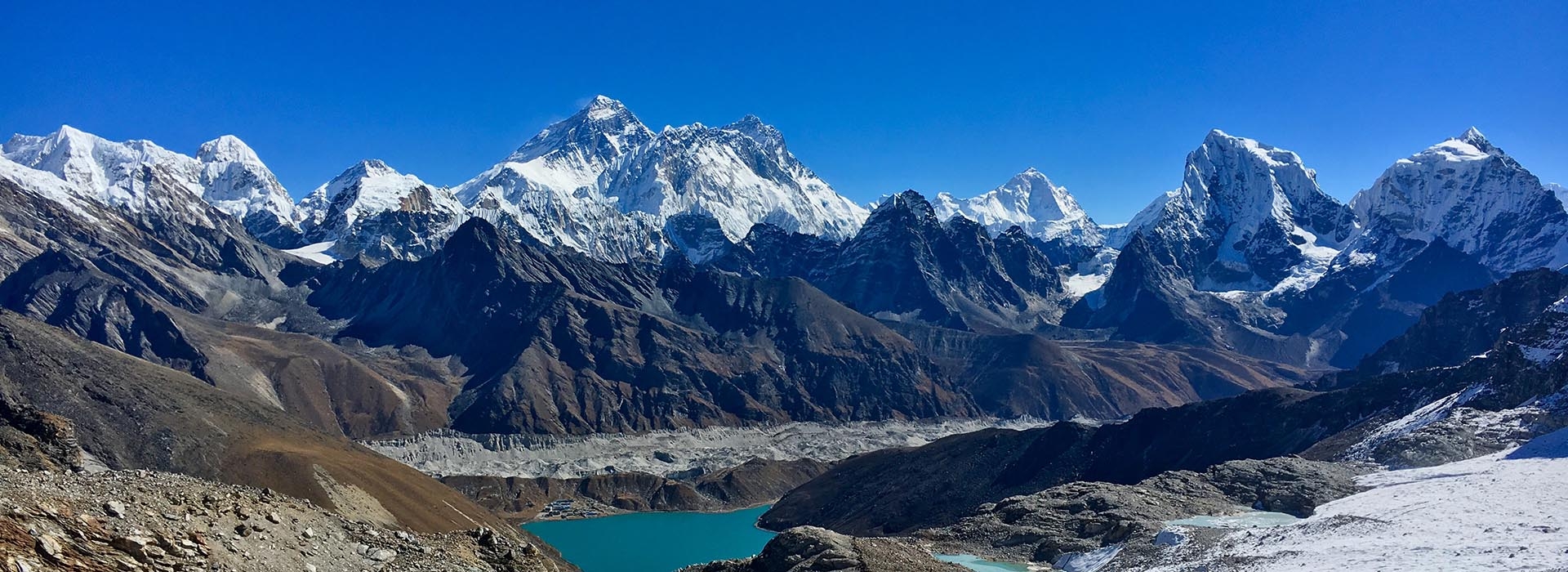
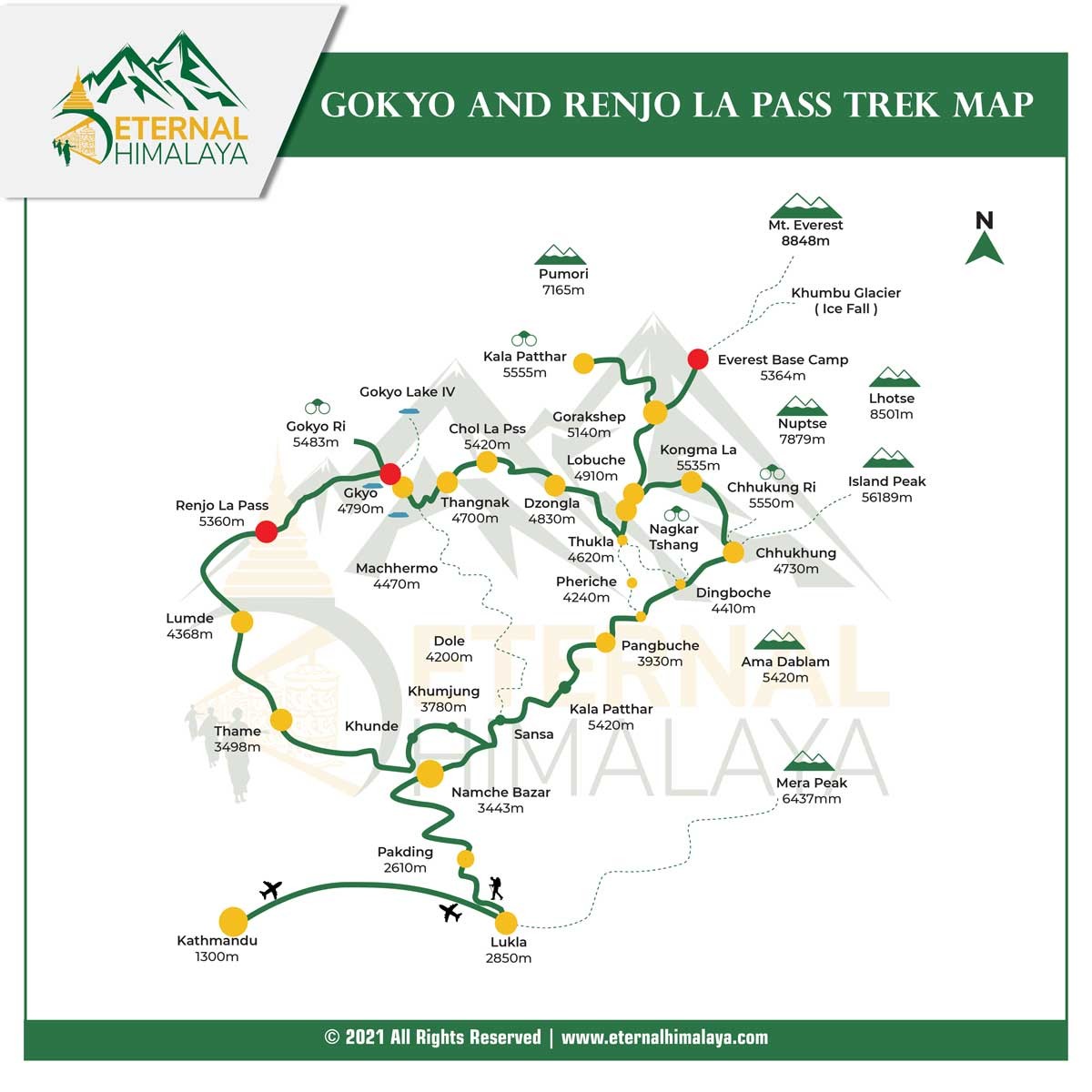
.jpg)

